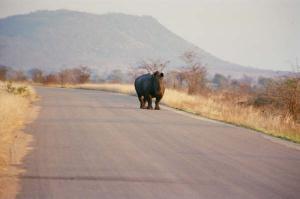
 This is my road
This is my road
Avoiding tourist traps
Travelling in South Africa with a car is challenging at the best of times. But when trying to avoid tourist traps and beaten paths, it takes the degree of difficulty up a notch. Add budget traveller and safety conscious person in a strange country and the difficulty degree soars – you’re out of lifelines.
You’re in the Driver’s Seat
The satisfaction of driving through a vast desert or coastal road is magnified greatly by the fact that you’re the one in the driver’s seat, it’s your elbow out the window. You’re also paying the border crossing fees, bribing the police and filling the vehicle with fuel. The best bonus of our own car is that Kruger is in reach.
We hire our car in Johannesburg from the only car company that will let us do so without a credit card or an armed robber motif. It is about a two and a half hour drive from South Africa’s capital to Kruger Park if you go the direct route, or just under four if you drive by the seat of your pants. If you are one of those people who imagine Kruger and similar parks like a big zoo, you are right.
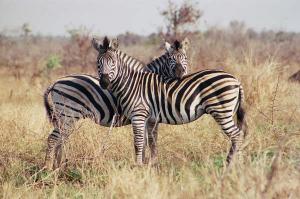
 We’re Twins
We’re Twins
Kruger National Park is big, as big as Wales. If you were to walk around its circumference, it would take six days, you could build London zoo inside over 14,000 times and still have room for a snooker table. It’s big.
We stay the night in Nelspruit and get an early start for our safari. The park has 11 entrances. Considering the park’s size and interior speed limit of forty, choosing the right entrance can be important. That is probably more for the prepared ones; we use the first one we come across.
We enter Malelane Gate, off the N4 from Nelspruit. It costs 240 rand (32.66 U.S dollars) for two days for two, camping permit included. It is recommended that accommodations be booked six months ahead, even for a camp spot, but the man at the gate says there is no need. It’s like crossing a border post – forms to fill out, money to pay, lines to attach yourself to. Once you cross, you’re in another world.
Another World
There is a map of the park at the entrance giving details on current animal sightings. Black pins indicate buffalo, grey elephant, red lions, yellow leopards and orange rhino. These five animals are the most precious to sight, together they make up the big five – a term I was to hear frequently in this new world.
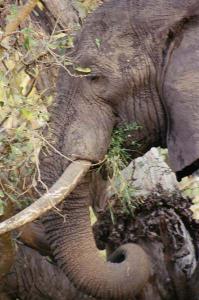
 My Breakfast, Lunch and Dinner
My Breakfast, Lunch and Dinner
Kruger is one of the best places to see animals in their own environment. Yes, there are roads weaving through the park passing rest areas, camping spots and the occasional fuel pump. Apart from that, it’s an animal lover’s paradise. Cars are limited to forty kilometres an hour in 90 percent of the park, which makes it safe for the animals and easier for you to spot them.
The animal is king, it has right of way. If confronted by a grouchy rhino looking like he has never lost a game of British bulldog or red rover, you let him pass, oh yes. We spend the first day looking for the big five, anything that crosses our path. Not knowing much about how to spot an animal, but well versed in national geographic specials, we guess the animals congregate around water. So we gather around water.
On the Lookout
I spot alligator twigs, found floating wherever alligators are expected. (I picked up a useful bit of information from the brochure we received upon entry to the park). If you see fresh animal droppings, you can assume wildlife was nearby recently. So we follow the poo trails – a game – which animal, how long ago, what speed and direction is the animal going. After a while you get good at it, to the point of winding down your window to get a good smell for freshness. Steam calls for a celebration!
We slowly crisscross the park, seeing different animals and their droppings. Monkeys play for us, a hornbill bird does its best impression of a toucan. We find a few zebras willing to pose for a picture. No sign of the big five, though, so we stop at one of the rest areas – the only places you are allowed out of your car.
Rest Areas
The rest areas consist of a kiosk, a picnic place and sometimes, accommodation. A three-meter high fence runs around the circumference of the grounds to keep the most dangerous animals at bay. I feel like I have traded places with the animals at the zoo. We sit under a picnic shelter, I sense we are being watched. I look up and realise we are sitting under a colony of bats nestled in the beams. We retreat quickly, fearing guano more than staring mammals.
You can buy souvenirs, snacks and postcards in the kiosk. A common snack throughout South Africa is biltong, African version of jerky. Earlier in our travels we came across an ice cream parlour that sold assorted biltong, but it was arranged next to the candy, giving the impression you can have gummy-bear-impala-choc-mint ice cream. It’s an acquired taste.
The kiosk also sells elephant biltong. In a reserve dedicated to the preservation of the animal kingdom, enticing nature enthusiasts to not only observe these magnificent beasts, but also try them with lashings of chilli salt, seems morbid. Elephant biltong is made from elephants that die naturally in the park, the proceeds benefit the reserve.
Kruger has about 36 tonnes of ivory in storage at a secret location, valued at approximately three million dollars that can’t be sold due to a ban of ivory trade implemented in 1989. Botswana, Namibia, South Africa, Zimbabwe and Zambia want to open the ivory trade, use the proceeds for elephant conservation. Some think this would encourage poaching and do more harm than good. Either way, the biltong turned out to be a good omen, if a little chewy.
Elephant Herd
Elephants are impressive in the wild. We see a small herd crossing a patch of open savannah, including two young ones. We watch from the car, using binoculars because we are a hundred metres away. After fifteen minutes, they leave our view. They make no sound, being stealthy. The bottoms of their feet are sensitive, they can walk without breaking loose twigs, when necessary. The fact that they don’t make vibrations that echo across the wilds doesn’t stop us from feeling like we are in Jurassic Park.
We are heading slowly, to Lower-Sabie, our chosen rest stop for the night. We turn a bend and see a herd blocking our path. We shut the engine and watch – in fascination and awe. The elephants pay no attention to us, they continue feeding, stripping branches of leaves and enjoying the afternoon cool. There are no young, we feel safe.
One big male finds the leaves on the tree near our car superior to the other eight billion in the park! (I now know how the cabdriver in Godzilla felt when the big lizard looked through his window). With less than two metres separating us from the elephant, we realize how potentially dangerous these animals can be. Yet we don’t sense danger, we do resist making any sudden movements. It takes half an hour before the herd ambles on.
Considering the 20-kilometer speed limit, we almost miss curfew. Even though the ranger told us we didn’t have to book in advance, he said we needed to be at the gate by 6:00 p.m. No unauthorised cars are allowed on the road at night, gates are locked. When we reach the reception desk, we aren’t so sure of an accommodation. The couple ahead of us are berated for almost missing curfew. We’re next. We also almost missed curfew and we don’t have a booking. Our hosts are not happy, but I am confident we won’t be sent back into the wild.
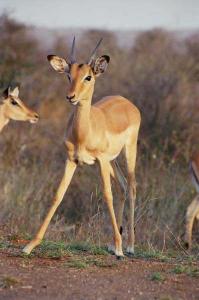
 Hello
Hello
Back on the Road
We set off at 6:00 a,m,, when the gates open. We realise there is almost no chance of spotting animals until the sun comes up. We park at a nearby waterhole and wait. The dim predawn light constricts our view. As we wait for the sun to come up, a shadow emerges in the middle of the water hole – a silhouette of one of the most deadly animals in Africa, the mighty and fearsome hippo. It is responsible for many deaths in Africa each year and has the cutest little ears!
Having already seen a hippo, we are hopeful. The surrounding flora, though, is knee high, helping camouflage our elusive five animals. Not long into our drive, we encounter our first giraffe. Having only ever seen a giraffe portrayed in cartoons, or in enclosures at the zoo, I had assumed them to be ungainly, long necked donkeys. Commonly thought of as the nerd of the savannah, I am struck by the giraffe’s elegance.
Giraffes
We drive slowly around a bend and see three adult giraffes and a baby. The baby is intrigued by the car, the adults are not phased. The pack is crossing the road, when they reach the other side, they graze the tops of trees for foliage, then lope off, camouflaging themselves surprisingly well considering their height. As we watch them glide into the wilderness, a car pulls up alongside ours, heading in the opposite direction. The people ask if we are interested in seeing some lions. There are a few three kilometres ahead.
King of the Jungle
We go towards the king of the jungle, scanning the low grass for any sign of movement, taking every precaution so we won’t miss our chance. We spot the cars, about four of them pulled over, the occupants staring intently, their fingers poised and ready on their cameras. We pull up behind the last car, scan for the big cats. There’s a male lion and two lionesses, in the middle of mating. Due to the high grass, our vision is obscured. Then they stand up to stretch and yawn, the lion version of the post-coital cigarette.
Occasionally, persons grow tired of the scene, start the engine and head off. Cars inch forward to get a better view. An hour and two rolls of film later, we find ourselves at the front of the cue, the best seats in the house. Twenty or so cars are clambering for a position. News travels fast in the wild.
Hippopotamus
After sitting in the car for six hours, we search for a rest area with a view, have a picnic lunch. The rest area looks over a small lake. Soon two hippos appear in the water. They start baring their teeth and fighting. Their mouths are as big as a Jacuzzi, they weigh around 3.5 tonnes, fully equipped with 28-inch teeth, four sturdy legs, some with a grumpy persona as an optional extra. They are fearsome. This sighting beats the best dinner and show cabarets. Their grunts echo through the valley as they thrash about for territory. By the time the show ends, a small tour group and guide have joined us at the lookout.
Buffalo
We push on, zigzag the rest of the afternoon, catching numerous zebras, impala and kudu for a photo shoot. As we near the sun setting and our curfew, we point our car towards Bergendaal rest camp. We reflect, enjoy the magnificent hues of the African sun washing the landscape to a golden shine.
What do we see but a buffalo through bare trees, the third of the big five. He isn’t alone either; there is a small herd of them, looking at us as if we are a display in Ripley’s Believe It Or Not. We aren’t interesting enough, back to the captivating dry grass they go. Not wanting to miss our curfew, we don’t linger with our new bovine friends.
We Move On – To The Rhinoceros
The road is straight, we are driving into the sun, the landscape is featureless apart from the occasional tree. By the time we see the rhino, we are less than a hundred metres away. He stands in the middle of the road, not impressed with our four-wheeled threat. I turn off the engine, watch him eye us. Lucky for us, rhinos have poor eyesight. We are close enough to see the potential damage he could do, and though we are getting late for curfew, he intimidates us more than any receptionist can. Soon we bore him, he ambles away.
Next – Hyenas
We make it to the rest area in time to sign in with no trouble. They don’t even raise an eyebrow that we have no booking. We camp close to the fence, kept company by a few hyenas for some of the night. We exit the grounds the following morning and within a few kilometres, we have our first success of the day – hyena, turns out he’s guarding a mother and her cub. With the windows wound up and our faces suctioned to the glass, we hear the hyena’s famous laugh, up close – wheezy and menacing, easy to see why Disney has cast them as bad guys in more than one feature.
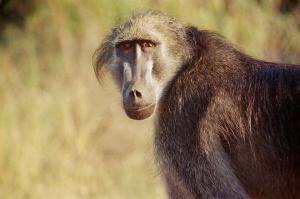
 What Are You Looking At?
What Are You Looking At?
Finally…
Reluctantly, we move on. Our goal is to spot a leopard (pardon the pun), the last of the big five. We hear there is one with three cubs. We hightail it to the scene, find two other cars waiting for the show. We settle in for the wait. Apparently, there are three cubs in a small rock cave, mother is nowhere to be found. Yesterday, though, four leopards were seen playing together out in the open. After three hours of gazing, without catching any sign of life, the day’s heat diminishing the chances of appearance, we go to the closest rest stop.
We see elephants and a dictionary of different impala species. We soak up the landscape for the last time. We allow extra time for a stop at the leopard cave – one last chance of spotting the spotted. We spend more time eying the rocks – nothing, a small disappointment after two days.
The wild is an enchanting place, no wonder it is such an inspiration for films and characters. At times in Kruger, you can relate to "The Lion King", "Madagascar". You may even think David Attenborough will pop up, do the voiceover. As they say in this neck of the woods, "It’s lekker bro."